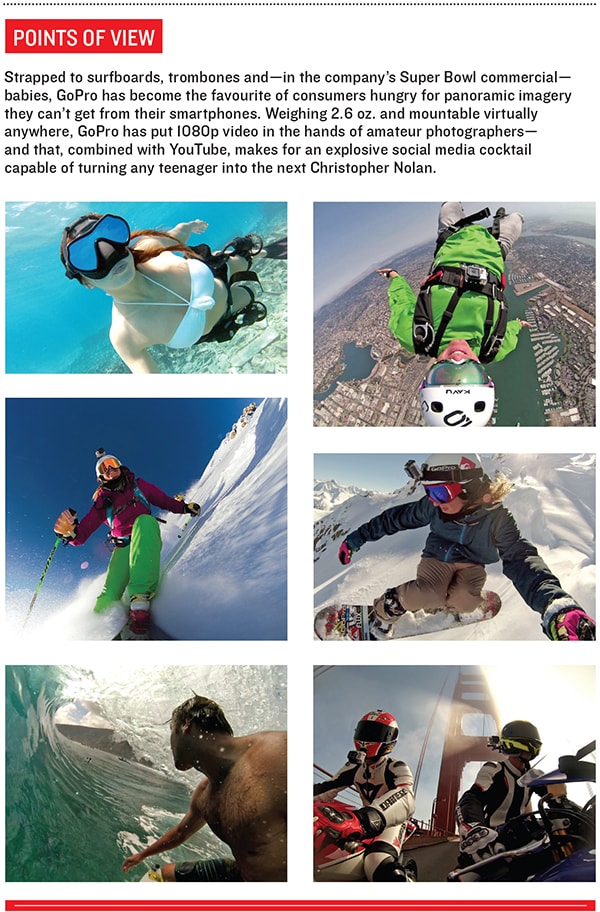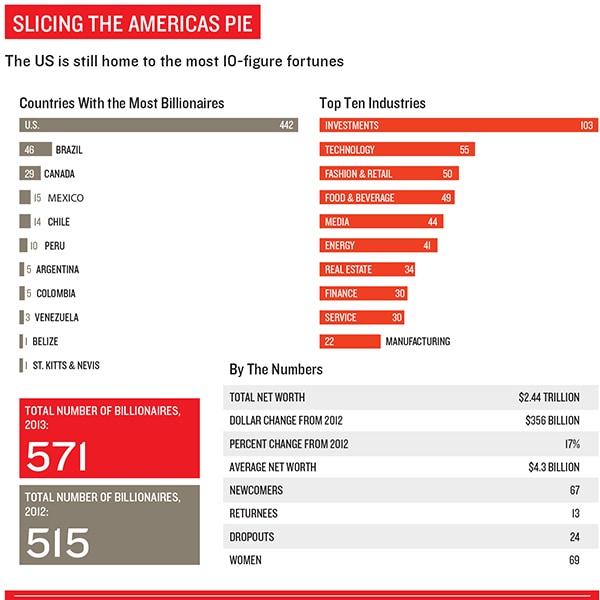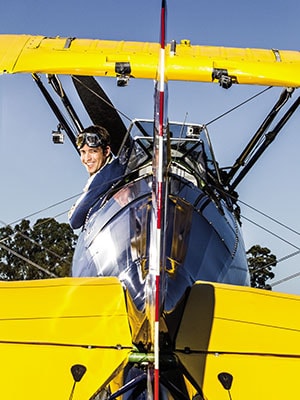
How the 'Do-What-You-Love' Model Made Billions
GoPro’s Nick Woodman lived to surf and take photos doing it. A reminder of the most powerful model in business: Doing what you love
Nick Woodman is 37 years old. His constantly tousled sepia hair and permanent, mischievous half-grin make him look 27. And he acts 17, as I learn 30,000 feet above the Rocky Mountains, after Woodman packed me, his wife Jill, and a dozen of his favourite colleagues and buds into a chartered Gulfstream III en route to Montana’s Yellowstone Club, the most exclusive ski hill in the US.
Already hopped up on Red Bull, tempered by a litre of coconut water, Woodman darts about the cabin, occasionally breaking conversation to unleash his trademark excited wail that friends liken to a foghorn. “YEEEEEEEEEEEEEOW.” A flight attendant emerges with breakfast on a silver platter. “You know what the best thing about morning ski trips are?” he asks the cabin rhetorically. “McDonald’s!” And with that he inhales a McGriddle in all of three bites.
The man-teen routine is more than an act: It’s the recipe for how he’s become one of America’s newest and youngest billionaires. A decade ago, Woodman craved a camera he could strap to his wrist so that his buddies could see his surfing exploits. The result is now a consumer phenomenon called GoPro, America’s fastest-growing digital imaging company.
Go anywhere active these days, whether it’s the mountains of Vail or the scuba-diving depths of Honolulu’s Hanauma Bay, and you’re bound to see a GoPro or 20. Kids these days don’t film their wave rides or half-pipe tricks. They GoPro them, strapping the $200 to $400 cameras to helmets, handlebars and surfboards. The cinema-grade, panoramic “point-of-view” footage that comes out of a GoPro transforms mere mortals into human highlight reels, without blowing a huge hole in the budget. Shaun White, who says he used to tape old cameras to his hand, used GoPros on his runs during the Winter X Games. Hollywood directors, including Michael Bay, keep crates of them on set. The NFL has tested them in their end zone pylons to capture touchdown replays. The Rolling Stones deployed them on stage. Police forces and the US military have started to incorporate the cameras into training exercises. Woodman, who calls it a “life” camera, proved the point by wearing one on his chest at the deliveries of his sons. On the plane to Montana, Woodman’s GoPro crew rigged their devices in every cranny in the cabin, including on the pilots’ heads, to document their journey.
GoPro sales have more than doubled every year since the first camera’s debut in 2004. In 2012, the company sold 2.3 million cameras and grossed $521 million, according to Woodman; with $100 million in sales in January alone, that annual figure should again double this year. For the month of December, GoPro was the highest-grossing digital imaging brand at Best Buy, knocking out Sony for the first time in the chain’s history. Just 10 years old, GoPro was responsible for 21.5 percent of digital camcorder shipments nationwide in the first half of 2012, according to IDC data. Among “pocket camcorders” that figure swells to a third.
This type of growth and niche dominance have made for a “rad” business proposition, with Chinese electronics manufacturer Hon Hai Precision Industry Co, better known as Foxconn, making a $200 million investment in GoPro in December. That valued the San Mateo, California, firm at $2.25 billion and shot Woodman, who sources say still owns about 45 percent of the company, onto the Forbes World Billionaires list with a net worth of $1.3 billion.
It’s a head-spinning turn of events for a 37-year-old Peter Pan running a billion-dollar technology company. As he barrels through Yellowstone’s freshly groomed powder in a pea-green helmet, it’s clear he’s found bliss. “YEEEEEEEEEEEEEEEOW,” he howls from his bloodied and chapped lips as he GoPros his every turn.
As the youngest of four children, Woodman has always been something of a schemer. Growing up in Silicon Valley’s prosperous Atherton (his father brokered Pepsi’s purchase of Taco Bell), he was, as his teachers recall, a “supremely confident” boy who wasn’t afraid to challenge those in charge. “There was always a smile on his face, either a great big one or a kind of sly, smirky thing,” said Craig Schoof, Woodman’s former baseball coach and history teacher. “There was the, ‘yeah, I’m happy’ or the ‘yeah, I’m happy, and I’m planning something.’ ” He once made a fiver by betting a biology teacher he could run a mile under 6 minutes (he ran it in 5:40).

Woodman focussed more on sports than books, maintaining a B+ average and copping a middling SAT score. He eventually became wave-obsessed, attending the University of California, San Diego, because of its proximity to sunshine and salt water. “I remember my parents not being very supportive of it,” he says. “But if I didn’t follow my passion for surfing ... I would have never come up with the concept to make a wrist camera.”
That concept came a few years after college after an online gaming service he started, Funbug, went belly-up in the dotcom crash of 2000-01, taking with it $3.9 million of investors’ money. “I’d never failed at anything before except computer science engineering classes,” he says. “So it was like, ‘Holy s--t, maybe I’m not capable of doing this.’”
To get his head straight again, Woodman lit out on a surf odyssey through Australia and Indonesia, one last big trip before what he figured would become a life of comfortable middle-class monotony. He brought a contraption he’d made out of a broken surfboard leash and rubber bands that allowed him to dangle a Kodak disposable camera to his wrist for easy operation when the perfect wave hit. Close friend and current GoPro creative director Brad Schmidt met Woodman in Indonesia and became one of the first to toy with the strap. One of his first observations: Woodman needed a camera durable enough to take the wear and tear of the sea. Five months into being a surf bum, a recharged Woodman returned to California with the seed of an idea.
“After he took off, he was like, ‘I think I’m going to start this wrist strap company for surfers,’ ” says Schmidt, who was sceptical. Says Woodman: “I thought to myself, ‘If I made a few hundred grand a year, I’m, like, in heaven.’ ”
Woodman, then 27, holed up in the house he shared in Moss Beach, California. He “checked out” from his normal life, including friends and family, locking himself in his beachside bedroom to build his first prototypes. Deciding that he had to sell the strap, the camera and the casing, he armed himself with a drill and his mother’s sewing machine and strapped a Camelback filled half with Gatorade and half with water to his back (negating the 30-second walk to the kitchen) for 18-hour work sessions. “I’d have a sliding door to the outside so I could just go take a pee out on the bushes out on the side,” Woodman recalls. He gave himself four years to make it work before he would drop his idea and enter the workforce. “I was so scared that I would fail again that I was totally committed to succeed.”
Between sewing together old wet- suit material and drilling holes in raw plastic, Woodman was constantly trolling online and at trade shows for a camera he could modify and licence as his own. He settled on a $3.05 35-millimetre model made in China, and he sent his plastic cases and $5,000 on a prayer to an unknown entity named Hotax. He received his 3-D models and renderings a few months later and sold his first product in September 2004 at an action-sports trade show in San Diego.
That was the first validation for Woodman, whose friends thought their former surfing buddy had held his breath underwater for a little too long. Neil Dana, his roommate and first hire, recalls a work-obsessed guy constantly fixated on success. “We would be at a party,” Dana recalls, “and he would come up the stairs and be like, ‘Dude, check this out, this is how we’re going to become millionaires!’” Woodman was only three zeroes off.
GoPro grossed $350,000 in its first full year of sales. Woodman was the all-in-one product engineer, R&D head, salesman and packaging model. He and Dana rang up surf shops across the country hoping to get some of their product out of Woodman’s father’s home in Sausalito and into the market. In 2005 he appeared on QVC three times, running into Spanx founder and fellow future billionaire Sara Blakely while she was building her company as well. (“If she remembers me, I’ll be amazed,” says Woodman. “But I’d love to get word to her to give her a digital high-five on crushing it.”)
Woodman eschewed venture capital as he grew—a by-product of his Funbug experience and a desire to work without suits interfering. Says Dana, “He wanted to keep it private for as long as possible so he could get a Lotus for ‘product testing’ and do things and not have to answer to a board about it.” At the outset, Woodman dropped in $30,000 of his own money, as well as $35,000 from his mother and two $100,000 investments from his father. The company made money from that point and today boasts profit margins, Forbes estimates, around 15 percent. It wasn’t until May 2011 that GoPro took on $88 million from five venture firms including Riverwood Capital, led by former Flextronics CEO Michael Marks, and Steamboat Ventures, Disney’s venture invest- ment arm, which allowed him, his family and some early executives to take a good chunk of cash out.

That’s how Woodman can now fly via G-III, versus the days he spent sleeping out in his 1971 Volkswagen bus or driving Penske trucks to set up trade show booths with accessories he would later return to Home Depot after use. Back then, he was a trade show fiend, learning to sweet-talk executives and sell his passion on the floors of conference centres from San Diego to Salt Lake City. His big break: REI. Woodman spent months messaging executives and shooting over progress reports before the outdoor sports giant succumbed, giving the company (which is still technically called Woodman Labs) a huge dose of validation.
With 2007 revenue in low seven- figures, Woodman had a crisis of confidence. GoPro’s founder worried that he “couldn’t take the company any further” and agreed to turn over majority control to a group of outside investors. And that deal likely would have gone down except for the 2008 financial crisis. The investors wanted to lower the valuation, and Woodman, his pride hurt and his spine stiffened, refused. “We were going up and to the right, and the economy wasn’t even af- fecting GoPro,” he says. The company wound up exceeding $8 million in sales that year, and has continued its organic growth. The next turning point came in 2010 when Best Buy began carrying GoPro. Woodman’s little idea had gone mainstream.
A little more than 72 hours after the ski trip to Big Sky country, a handful of GoPro’s media team and I are half a mile off the coast of Half Moon Bay, California in a watercraft normally reserved for Navy Seals. Two hundred yards away, the world’s best surfers hurtle down the famed Mavericks surf break armed only with longboards, hubris and, yes, GoPros.
From our vessel, which is part of a 40-watercraft flotilla of paddleboards, pleasure craft and dinghies, we watch 35-foot waves crash and clatter, mixing sea spray with diesel fumes. Woodman tested the first GoPro prototypes near these same icy waters. If you look around, you see the cameras are ubiquitous, dangling from the mouths of surfers, held up by spectators and strapped to the helmets of Jet Ski-zipping water rescuers. “You gotta GoPro the GoPro boat,” yells out one onlooker from her craft, proceeding to point her gray box toward our vessel. Hours later, footage of our boat and the day’s surfers ends up on YouTube.
And, indeed, social media friendli- ness explains how GoPro went from niche to blockbuster. In the hands of the right athletes, the footage shot on a point-of-view action camera is viral crack. For weekend warriors, it’s the easiest way to get your own three minutes of glory.
Though Woodman personally lacks a Twitter account and is inactive on Facebook, he spends millions of dollars a year to make sure the GoPro name is hashtagged with that blood-pumping shot of the GoPro-backed snowboarder Shaun White pulling off a 1080, or Felix Baumgartner plunging towards the ground from the upper echelons of Earth’s atmosphere (Baumgartner wore five GoPros on his record-breaking jump). “We’re building one of the world’s most engaging and exciting consumer brands, and it’s largely on the content that our customers are creating with their GoPros,” Woodman says. GoPro boasts 222 million views on its YouTube channel and 4.7 million likes on Facebook.
“It’s funny to see so many people with them, but it makes sense and that’s great for the brand,” says surfer Kelly Slater, one of the many GoPro-sponsored athletes. “They’ve quickly monopolised the idea in a way Band-Aid or Q-tip has where everyone refers to these types of shots as GoPro shots or expect it must’ve been shot with one.”
GoPro’s competitors are the first to acknowledge this. Giovanni Tomaselli, founder of action cameramaker iON Worldwide, says Woodman “deserves to be a billionaire” for his innovation and that iON had “taken a leaf out of [GoPro’s] book” when it came to promoting its first products, which launched in 2012. But he remains defiant: “We do not believe this category is one-size-fits-all.”
There are also those who believe the category may not be here to stay. While smartphones killed the need to own camcorders like the ill-fated Flip Camera, they may also have the capacity to one day become the device that takes out GoPro. Valley venture capitalist Greg Gretsch calls GoPro an “ephemeral opportunity”. “The issue is that they’re a hardware manufacturer in a world that’s quickly moving to the überplatform: The smartphone,” he says, pointing out that iPhone and Android operating systems have hundreds of developers writing software everyday.
Meanwhile, GoPro must now deal with the big boys, who have finally taken note of his success. Sony shipped its first action cameras in September and says it is positioning itself as a “strong number two” with features like image stabilisation and stereo sound, which GoPro currently lacks. “We’re a camera company first,” says Sony product manager Greg Herd. “GoPro is a mount company first that sourced to cameras.”
Woodman says that the market he created is big enough for multiple companies. And he’s only too happy to point out the stat about outselling Sony at Best Buy in December. “For the first time, Sony got beat, and it was GoPro?” Woodman asks rhetorically. “That’s pretty awesome.”
Nonetheless, he’s also smart enough to know that GoPro needs to step up its game. Which likely explains the recent Foxconn deal, which brought in $200 million. Woodman says that no one in the company has taken out a penny, giving him a very formidable war chest. The intended use? “Strictly confidential,” Woodman says. And while they don’t need the cash for now, Woodman doesn’t rule out the possibility of a public offering. “It’s something that we think about: Would being a public company put us in a better position to compete?” he says. “We’ll see.”
Two months after closing the Foxconn deal, Woodman is trying to say the word “awesome” again, but in an open cockpit at 2,000 feet it’s a little hard to talk. Soaring above the vineyards of California’s Sonoma County in a World War II-era biplane, GoPro’s founder flaps his arms in sheer bliss. He takes the pilot’s barrel roll to little ill effect and salutes a stomach-knotting midair stall known as a hammerhead with his trademark yell, “YEEEEEEEEEEEOW” which is quickly swallowed by the sound of the plane’s propeller. Having conquered the slopes and the sea, Woodman now wants to make GoPro the go-to device for capturing “life’s precious moments”. He’s not the only one who thinks that. “My vision is to help global consumers build an ecosystem in which capturing, sharing, viewing and creating content on any device at any time in any place is convenient, effortless and cost-effective,” says Foxconn CEO Terry Guo, who now sits on the company’s board. “GoPro fits well into that ecosystem.”
That’s a big leap. But GoPro’s trajectory still remains up and to the right, and will continue that way as long as it finds new uses and markets for its cameras. “If we can become the de facto standard for image capture of unique perspectives around the world we have a lot of growth ahead of us,” Woodman says. Capturing some of those unique perspectives are the eight GoPros trained on the CEO as he exits the biplane. As he unbuckles himself from his harness and hops out of the plane, the cameras catch some of his first words once he’s back on the ground: “This does not suck.”
(This story appears in the 30 November, -0001 issue of Forbes India. To visit our Archives, click here.)





